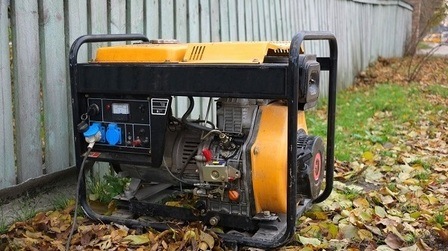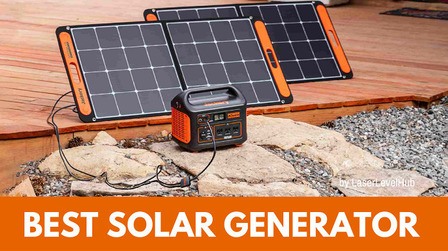The introduction of the portable generator makes it an exciting time to live. These machines can quickly put out thousands of watts and power during electricity outages, or when you have ventured far away from civilization. Most of these machines pack sufficient power to meet the electricity needs of the average households or small businesses.
Better yet, compared to the standard backup generator, they are compact and easy to carry around. As a result, the portable generator has been crucial in powering and keeping afloat most trips, hikes, and camping sessions in locations where access to grid electricity is limited.

But as is the case with any machine out there, you need to equip yourself with proper knowledge of how to get the most out of your portable generator.
Pertinently, we are fortunate to be part of a team that, through immense experience and trial and error, has amassed a bag of information on the approaches to productively and safely using the equipment. Join us in this post as we share with you the tips for safely using a portable generator.
9 Safety Tips For Using a Portable Generator
1 - Read the Manual
Before you begin using your machine, always double-read the instruction manual which accompanies the machine for clear guidelines and cues on how to properly set up, operate, care and troubleshoot the specific machine. The user manual will also enlighten you on all the available modes, components, and their functions.
If you lack a manual, visit the manufacturer’s website and try to download the swing machine manual of the specific model you own.
2- Carry Out Routine Maintenance
Proper routine maintenance is the name of the game with any machine, and portable generators are a prime example of one. Having a capable portable generator and not taking care of it is a sorry waste of time and money. You need to carry out routine maintenance checks, regularly inspect the parts, and repair or replace the rogue components.
Ahead are some basic practices you need to put in place to ensure your generator remains on top of its game
Inspection

The fuel pipes are prone to cracking, clogging, and wear. Carry out frequent inspections and check the state of your spark plugs, filter, pipes, pump and valves, control panel, switches, and voltage meters are still in a workable state.
Look out for worn-out, broken, or misaligned parts, and leakages when the generator is clean and dry. Not just that. Check for any notifications on the control panel and alarm sounds, and try to identify any faults.
If the faults are reparable or the parts are completely out of order, do not hesitate to call a technician for engine service and diagnosis, but if the damage is beyond mending, simply replace the part.
Lubrication
Generators have rotating units and moving parts that demand regular checkups and maintenance. On a timely basis, ensure you lubricate the moving parts and change the oil, replace wear-prone parts like bearings, and check and tighten bolts and electrical connections.
Before turning on your portable generator, check the level of fuel and coolant. Consider doing a manual check since the gauges are susceptible to failure or malfunctioning. Refill if there's a need.
If your generator is new, you will need to do the first oil change after 20 – 30 hours of operation. Afterward, changing the oil after 50-60 hours is in order.
You do not want to be shopping for fuel, oil, or filters during a power blackout. Always keep some fuel and oil and oil filters as a backup in case of shortage or failure.
Cleaning
Clean the engine, tank, and pipes regularly to free it from any dust, dirt, or carbon build-up and small pests like cockroaches. They may compromise with smooth functioning and restrict the free supply of fuel.
Clean the fuel tank from time to time and release the pressure, and carefully check the pipes for any blockages. Use a clean rage dipped in a degreaser to clean these units. Avoid using pressure washers, they may damage the delicate components of the machine.
Apart from that, check the air filter for dirt. If it requires cleaning; wash the air filter in soap water, dry gently using a clean cloth, and allow time to dry. It is advisable to clean the filter after about 100 hours of use and replace them after no more than a month of use.
The spark plug also requires cleaning after about 100 hours of running to keep at bay dirt, oil residue, and carbon buildup. Use a clean wire brush or spark plug to rid of these deposits.
Proper Storage

Always store the generator in a cool dry place and cover it during storage to prevent the entry of dirt and dust. Such particles can block the air duct and prevent the free flow of air. Ensure you clean the cover from time to time to free it from dirt and dust.
The last thing you want is to be looking for a way to charge your battery during a storm that has knocked your utility power supply. So, we recommend powering your generator on for a couple of minutes every 90 days to allow circulation of oil through the engine, keep the parts lubricated and keep the battery charged.
Clean the entire unit and ensure all the air slots and opening are clear of any dust or dirt. Remove the battery and wipe clean the posts
You do not want corrosion in the cylinder bore. To prevent it, occasionally remove the spark plug during long storage and inject several drops of oil into the plughole. Pull the recoil starter knob a couple of times replacing the plug.
3 - Check the Wattage Capacity
Ensure the wattage capacity of the generator can comfortably accommodate the load without exceeding the threshold. Along with that, see to it that the load is ¾ the total capacity of the power equipment to prevent wet stacking.
Common signals of an overworking generator with excessive load are heavier than the usual sound, and underpowered appliances. As soon as you notice these indications, reduce the load.
Check the labeling on the generator or confirm with the manual for the wattage rating. Usually, there are two types of ratings listed; the ‘starting’ or ‘maximum’ rating and the ‘running’, ‘rated’ or ‘continuous’ rating.
The starting rating is the extra amount of wattage the power-producing tool can give out in very short durations after powering on - usually higher than the latter. Meanwhile, the running wattage entails the amount of power the generator can put out over long durations. Therefore, use the running wattage to determine if the power-producing unit can handle the load.
Additionally, avoid connecting heavy power hogging appliances such as freezers and cookers. Make sure the light bulbs you fit are all Energy Star certified and have insulating features. If you intend to use large electrical equipment, you may want to consider the more powerful standby generators rather than portable units.

4 - Do not Run the Generator without Fuel
Check the oil gauge if the fuel available is sufficient for your needs. Although running out of gas amid operation stops the production of power, the load may continue draining the magnetic field from the generator. The generator may run fine during subsequent uses, but it may not produce power.
The solution is to maintain optimal fuel level and disconnecting the electrical load before turning off the portable power generating machine.
The choke should be turned off after starting the generator. The choke works by providing more fuel to the engine, enhancing the mixing of fuel and air, and reducing the intake of air. This enables quick ignition of the engine.
5 - Avoid Old Fuel
Furthermore, if you are going to tuck it away for an extended period, make sure you empty the fuel tank and engine before storage. It’s worth noting that when fuel stays in the engine and fuel tank for a long time, oxidation occurs forming a sticky gum-like compound that may damage the components of the engine. Fixing this issue requires a fuel stabilizer.
To drain the engine, wait for the system to cool before opening the drain. If not, run the engine after emptying the tank until the gas runs out.
That's not all. The shelf life of the oil is usually about 5 years so you will want to keep that in mind if you will not be using the generator regularly.
6 - Proper Positioning

The portable generator should be placed on a hard and flat surface. A tilted generator is susceptible to lead to leakages and spillages on the air filter. Moreover, it should be well ventilated and preferably outdoors to allow for the free flow of air and quick dissipation of the fatal emitted carbon monoxide.
Refrain from running the machine indoors or from partially enclosed spaces like garages and basements, even if the doors and windows are open. Such locations restrict the free circulation of air and may lead to a buildup of highly toxic carbon monoxide gas.
Avoid leaving the generator running in the rain or wet conditions. Instead, cover it with a waterproof material or put it in a shade such as a portable generator garage.
7 - Use Heavy Duty Wiring
Always use heavy-duty 12-gauge power chords. Light cords can cause decreased voltage which often results in premature burnout of appliance motors. The generator should be at least 20 feet away from where you will be sitting.
Even so, place the power equipment no further than 100 feet away from the load since a very long wire run loses a great deal of current.
8 - Safety When Refilling Fuel
Gasoline and diesel are highly flammable and may ignite if they come into contact with hot parts of the engine. And because spillages are unavoidable during refueling, make sure you turn off the engine and allow it time to cool before adding fuel to the tank. Store fuel in proper containers and keep the fuel containers far away from fires.
Not to forget, as soon as you notice any strange odor or smoke, quickly shut down the machine.
9 - Never Try Back-feeding!

Never try to back feed your house or building. That’s not how the generator world rolls. Back feeding means trying to power your house or other electrical systems by attaching a generator directly to a power outlet. Back-feeding can damage your appliances and even worse, lead to electrocution. Plug your appliances directly to the generator outlet using the provided wiring and extension cords.
Parting Shot
Although the portable generator may not even come close to meeting your energy needs, it is quite handy in supplementing your energy production and filling in during utility-power outages.
As people who have been around generators since the '90s, we chose to share with you all the tips and tricks you need to have at your fingertips when using a portable generator. Remember, whether you have been using generators for 20 years or two days, there are always new lessons to learn.








